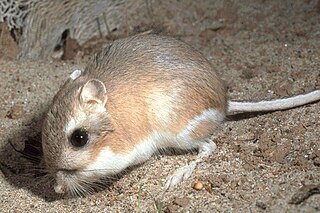Genus /ˈdʒiː.nəs/ is a taxonomic rank used in the biological classification of living and fossil organisms as well as viruses. In the hierarchy of biological classification, genus comes above species and below family. In binomial nomenclature, the genus name forms the first part of the binomial species name for each species within the genus.
180,000 species of Lepidoptera are described, equivalent to 10% of the total described species of living organisms. This is a list of the diversity of the Lepidoptera showing the estimated number of genera and species described for each superfamily and, where available, family. See Lepidoptera for a note of the schedule of families used.

The genus Pygoscelis ("rump-legged") contains three living species of penguins collectively known as "brush-tailed penguins".

Castorimorpha is the suborder of rodents containing the beavers and the kangaroo rats. A 2017 study using retroposon markers indicated that they are most closely related to the Anomaluromorpha and Myomorpha.

The genus Sciurus contains most of the common, bushy-tailed squirrels in North America, Europe, temperate Asia, Central America and South America.

Erodium is a genus of flowering plants in the botanical family Geraniaceae. The genus includes about 60 species, native to North Africa, Indomalaya, the Middle East, and Australia. They are perennials, annuals, or subshrubs, with five-petalled flowers in shades of white, pink, and purple, that strongly resemble the better-known Geranium (cranesbill). Cultivated plants are known as filarees or heron's bill in North America, whereas in the British Isles they are usually called storksbills.

Undorosaurus is an extinct genus of ophthalmosaurid ichthyosaur known from western Russia, Svalbard, and Poland.

The Arthoniaceae are a family of lichenized, lichenicolous and saprobic fungi in the order Arthoniales. The Arthoniaceae is the largest family of Arthoniales, with around 800 species. Most species in Arthoniaceae belong in Arthonia which is the largest genus with 500 species. The second and third largest genus is Arthothelium with 80 species, and Cryptothecia with 60 species.

Agrotera is a genus of snout moths in the subfamily Spilomelinae of the family Crambidae. It is the type genus of the tribe Agroterini and currently comprises 28 species distributed in the Afrotropical, Palearctic, Indomalayan and Australasian realm.

Conchylodes is a genus of snout moths in the family Crambidae. The genus comprises 21 species and is placed in the tribe Udeini.

Lineodes is a genus of snout moths of the subfamily Spilomelinae in the family Crambidae. The genus was described by Achille Guenée in 1854, with Lineodes hieroglyphalis as the type species.

Bepea is a moth genus in the subfamily Spilomelinae of the family Crambidae.

Sauroniops is a genus of carnivorous basal carcharodontosaurid theropod dinosaur known from the Late Cretaceous of Morocco.
"Beipiaognathus" is a dubious genus of coelurosaurian theropod from the Early Cretaceous Yixian Formation of Liaoning, China. The type species is "Beipiaognathus jii" and it was named and described by Hu et al. in 2016.

Huinculsaurus is a genus of noasaurid dinosaur from the Huincul Formation in Neuquén Province, Argentina. The type and only species is Huinculsaurus montesi. It was probably around 3 metres (9.8 ft) when fully grown, although this is only speculation since no fully mature specimens are currently known.
Gaisler's long-eared bat is a species of bat in the genus Plecotus. It is a medium-sized grayish-brown and found in Morocco, Algeria, Libya, and Tunisia.
Kompsornis is an extinct genus of avialan that lived during the Early Cretaceous period of China. The type and only known species is Kompsornis longicaudus; the specific name means "long-tailed". It is known from only a single fossil specimen from the Jiufotang Formation. Kompsornis was closely related to the well-known Jeholornis, another long-tailed avialan from China, but differs from it in features of its skeleton, particularly the fusion and growth rate of its bones. Like other jeholornithiforms, Kompsornis was a long-tailed avialan with long wings and possessed little or no teeth, with none identified in the single specimen of Kompsornis.
Mockina is an extinct genus of Late Triassic conodonts. Several species of Mockina are used as index fossils for the Alaunian and Sevatian substages of the Triassic. One species, Mockina bidentata, is considered to be ancestral to Misikella and Parvigondolella, some of the last known genera of conodonts. Mockina has occasionally been synonymized with Epigondolella based on the assumption that it represents Epigondolella specimens which live in resource-poor environments. Mockina/Epigondolella multidentata has occasionally been considered to belong to its own genus, Orchardella.
Parvigondolella is an extinct genus of Late Triassic conodonts. The most common species in the genus, Parvigondolella andrusovi, is used as an index fossil for part of the Sevatian substage of the Norian stage. Kozur & Mock, 1991 named two additional species, P. rhaetica and P. vrielyncki. Moix et al. (2007) later argued that "Misikella" rhaetica was a species of Parvigondolella. In order to prevent having two different species with the same name within the genus, they renamed Kozur & Mock (1991)'s P. rhaetica to P. prorhaetica. However, this would be unnecessary if "Misikella" rhaetica was not related to Parvigondolella. Parvigondolella is typically considered a direct descendant of Mockina/Epigondolella bidentata.
Khinganornis is a genus of ornithuromorph bird from the Early Cretaceous Yixian Formation of Liaoning, China. The genus contains a single species, Khinganornis hulunbuirensis, known from a nearly complete fossil preserved on a slab and counter slab. The holotype most likely represents an adult individual.











